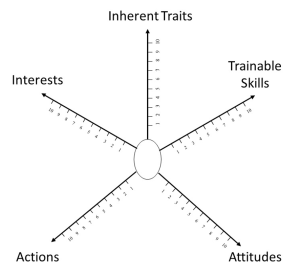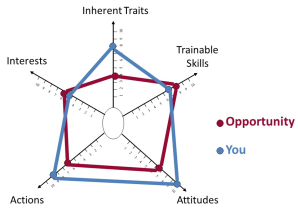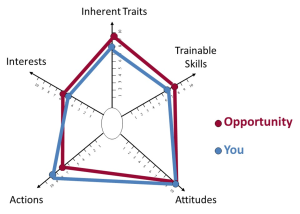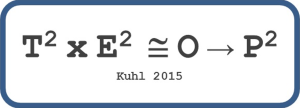 Now that we’ve got the concepts of Talent (T) and Effort (E) squared away, let me take this opportunity to explore the third and final factor in Dr. Marshall’s original Performance Equation. Opportunity (O) refers to the success potential available to you in any given professional environment (Marshall, 1999). As you may recall, in his model, Dr. Marshall asserts that the more closely your talent and effort levels match the known success attributes of a given opportunity, the more likely you are to thrive and flourish there. That is to say, the better your fit with the opportunity, the higher performance level you are predicted to achieve.
Now that we’ve got the concepts of Talent (T) and Effort (E) squared away, let me take this opportunity to explore the third and final factor in Dr. Marshall’s original Performance Equation. Opportunity (O) refers to the success potential available to you in any given professional environment (Marshall, 1999). As you may recall, in his model, Dr. Marshall asserts that the more closely your talent and effort levels match the known success attributes of a given opportunity, the more likely you are to thrive and flourish there. That is to say, the better your fit with the opportunity, the higher performance level you are predicted to achieve.
So what constitutes an opportunity, and how does it limit or enhance your potential for success?
Every career opportunity is unique. In your own life, when you’ve needed to weigh job options and to determine whether a given position was a good fit for you, you probably considered issues and questions such as:
 Career/Job Alignment
Career/Job Alignment
- How well does a particular career path or specific job role make use of your inherent strengths? Your current skills, knowledge, and abilities?
- How well does this opportunity align with your sense of who you are, what you believe in, and what you stand for?
- Is this position in a field or industry that interests you? That you believe is valuable to society?
- Results Needed
- Considering the immediate and the long-term results it will generate, is this opportunity worthy of your time, talent, and effort? Are the results meaningful to you?
- To deliver the results required by the position, what percentage of your effort will be devoted to meaningful work versus effort spent on busy work (as you personally define them)?
- Would you be likely to feel engaged and challenged while performing the tasks required to achieve the results required by this opportunity?
- Culture Environment
- Do the stated values and priorities of this organization’s culture align well with your personal values and priorities? And does the organization actually put its values into practice?
- Does the organization’s culture promote the levels of personal and professional growth that you seek?
- Will you be rewarded for your work in a way that is meaningful to you?
- Would you enjoy working in this environment, including the facility, the people, the energy level?
- Does the culture promote positive relationships among colleagues? Are your personal style, sense of humor, and personality quirks likely to be well-received?
- Does the culture promote work/life balance?
Clearly, the answers to these questions are unique and highly personalized. I believe it’s also pretty clear how putting yourself into an opportunity that is not a good fit could be career-limiting at best, and totally demoralizing at worst. To take just one example, you would be hard-pressed to feel energized and to consistently perform at your highest and best level if you were stuck in a role that felt like it was 90% busy work and only 10% productive time.
 Why, it would be like being a square peg in a round hole!
Why, it would be like being a square peg in a round hole!
Which brings me to Euclid. Do you remember Euclidean Geometry? It seems to me that I first encountered the joys of Euclidean Geometry fairly early in high school. I loved it! Messing around with dots, lines, angles, and polygons was much cooler than messing around with numbers and solving for x.
Thinking through Marshall’s concept of individual “fit” to an Opportunity being essential to Performance, I have an image from high school math class of trying to align one multi-sided shape with another multi-sided shape. And if they line up, they are said to be congruent. This concept of congruence strikes me as an elegant way to visualize how Talent and Effort do or don’t line up with any given Opportunity. In the spirit of Einstein, let’s perform a thought experiment.
 Here’s a graph with two axes for Talent (Inherent Traits and Trainable Skills), and two for Effort (Attitudes and Actions). I’ve also added an axis for Interests. You don’t need psychometrics, psychology, or neuroscience to tell you that you are unlikely to enjoy significant, sustained success working on something that doesn’t appeal to you, isn’t enjoyable on some level, or have some meaning and significance to you. (Much more about that later.)
Here’s a graph with two axes for Talent (Inherent Traits and Trainable Skills), and two for Effort (Attitudes and Actions). I’ve also added an axis for Interests. You don’t need psychometrics, psychology, or neuroscience to tell you that you are unlikely to enjoy significant, sustained success working on something that doesn’t appeal to you, isn’t enjoyable on some level, or have some meaning and significance to you. (Much more about that later.)
Imagine that you could indicate a point on each respective axis to represent the Talent, Effort, and Interests requirements of the job. Imagine also that you could map on those same axes points representing your Talents, Effort, and Interests. You could then compare the shapes to determine whether you were naturally suited to be a high performer in that role. Are they congruent? Or is it a square peg/round hole situation?
Using this image, it becomes pretty easy to see for which Opportunity your Talent and Effort are a good fit. Let’s look at a couple of examples. Note that in the diagrams, the red shape represents the requirements of the Opportunity, and the blue shape represents the shape of your natural strengths.
 In the first example, compared to the job requirements, your inherent traits are way out of whack—it appears that some of your inherent strengths would not be well used, although your trainable skills, knowledge, and abilities are pretty close to the requirement. Also, both aspects of your Effort exceed the position’s needs.
In the first example, compared to the job requirements, your inherent traits are way out of whack—it appears that some of your inherent strengths would not be well used, although your trainable skills, knowledge, and abilities are pretty close to the requirement. Also, both aspects of your Effort exceed the position’s needs.
In contrast, consider the second example. Same you-shape, different opportunity. In this case, it appears that what you have and what the  Opportunity requires are pretty close to being congruent. The Performance Equation predicts that you are much more likely to be a high performer in the second opportunity.
Opportunity requires are pretty close to being congruent. The Performance Equation predicts that you are much more likely to be a high performer in the second opportunity.
To express all this in plain English, rather than plane Geometry, you can achieve exponential levels of Performance when you work in a congruent Opportunity—one that aligns with your interests, respects your Attitudes, and rewards you for consistently putting your Talents (both Inherent and Trainable) into Action to the benefit of both you and the organization.
At the risk of offending all you true mathematicians and connoisseurs of formulae and precise notation, I express this enhanced variation of Marshall’s Performance question as my Exponential Performance Equation for individuals:
Talent squared times Effort squared while working in a congruent Opportunity yields Performance squared.
“But wait,” you may say. “You promised you’d ‘define your terms.’ So far, Performance hasn’t really been clearly defined.”
Yeah, I figured you’d notice that. And obviously, it’s a pretty significant question.
In Dr. Marshall’s initial research, Performance was measured purely in terms of net earnings in the context of a competitive sales environment—whoever bagged the most bucks was the high performer.
In thousands of validation studies across 35 years and numerous industries, the understanding of Performance has broadened. For our purposes, a high performer is someone who consistently meets and exceeds the defined results required by a particular job role. Remember, the original Performance Equation addresses performance and retention relative to one’s work life.
But wait—there’s more to life than just work! What does it mean to be a “high performer” when it comes to leading a good, fulfilling life?
Excellent question. Remember, my quest is to bring together current research in neuroscience, psychology, psychometrics, and predictive analytics to form a unified theory for how humans can be more effective and more fulfilled in work and in life. So now it’s time to explore Model #2.
~~~
